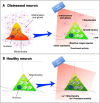Lights for epilepsy: can photobiomodulation reduce seizures and offer neuroprotection?
- PMID: 36571337
- PMCID: PMC10075120
- DOI: 10.4103/1673-5374.360288
Lights for epilepsy: can photobiomodulation reduce seizures and offer neuroprotection?
Abstract
Epilepsy is synonymous with individuals suffering repeated "fits" or seizures. The seizures are triggered by bursts of abnormal neuronal activity, across either the cerebral cortex and/or the hippocampus. In addition, the seizure sites are characterized by considerable neuronal death. Although the factors that generate this abnormal activity and death are not entirely clear, recent evidence indicates that mitochondrial dysfunction plays a central role. Current treatment options include drug therapy, which aims to suppress the abnormal neuronal activity, or surgical intervention, which involves the removal of the brain region generating the seizure activity. However, ~30% of patients are unresponsive to the drugs, while the surgery option is invasive and has a morbidity risk. Hence, there is a need for the development of an effective non-pharmacological and non-invasive treatment for this disorder, one that has few side effects. In this review, we consider the effectiveness of a potential new treatment for epilepsy, known as photobiomodulation, the use of red to near-infrared light on body tissues. Recent studies in animal models have shown that photobiomodulation reduces seizure-like activity and improves neuronal survival. Further, it has an excellent safety record, with little or no evidence of side effects, and it is non-invasive. Taken all together, this treatment appears to be an ideal treatment option for patients suffering from epilepsy, which is certainly worthy of further consideration.
Keywords: cell death; gliosis; inflammation; infrared; mitochondria; non-pharmacological; red; seizure.
Conflict of interest statement
None
Figures


Similar articles
-
Lights on for Autism: Exploring Photobiomodulation as an Effective Therapeutic Option.Neurol Int. 2022 Oct 27;14(4):884-893. doi: 10.3390/neurolint14040071. Neurol Int. 2022. PMID: 36412693 Free PMC article. Review.
-
Carbamazepine versus phenytoin monotherapy for epilepsy: an individual participant data review.Cochrane Database Syst Rev. 2019 Jul 18;7(7):CD001911. doi: 10.1002/14651858.CD001911.pub4. Cochrane Database Syst Rev. 2019. PMID: 31318037 Free PMC article.
-
Effects of Non-invasive, Targeted, Neuronal Lesions on Seizures in a Mouse Model of Temporal Lobe Epilepsy.Ultrasound Med Biol. 2020 May;46(5):1224-1234. doi: 10.1016/j.ultrasmedbio.2020.01.008. Epub 2020 Feb 17. Ultrasound Med Biol. 2020. PMID: 32081583 Free PMC article.
-
Glutamate receptor antibodies in neurological diseases: anti-AMPA-GluR3 antibodies, anti-NMDA-NR1 antibodies, anti-NMDA-NR2A/B antibodies, anti-mGluR1 antibodies or anti-mGluR5 antibodies are present in subpopulations of patients with either: epilepsy, encephalitis, cerebellar ataxia, systemic lupus erythematosus (SLE) and neuropsychiatric SLE, Sjogren's syndrome, schizophrenia, mania or stroke. These autoimmune anti-glutamate receptor antibodies can bind neurons in few brain regions, activate glutamate receptors, decrease glutamate receptor's expression, impair glutamate-induced signaling and function, activate blood brain barrier endothelial cells, kill neurons, damage the brain, induce behavioral/psychiatric/cognitive abnormalities and ataxia in animal models, and can be removed or silenced in some patients by immunotherapy.J Neural Transm (Vienna). 2014 Aug;121(8):1029-75. doi: 10.1007/s00702-014-1193-3. Epub 2014 Aug 1. J Neural Transm (Vienna). 2014. PMID: 25081016 Review.
-
Topiramate versus carbamazepine monotherapy for epilepsy: an individual participant data review.Cochrane Database Syst Rev. 2019 Jun 24;6(6):CD012065. doi: 10.1002/14651858.CD012065.pub3. Cochrane Database Syst Rev. 2019. PMID: 31233229 Free PMC article.
References
-
- Ahmed NAEH, Radwan NM, Ibrahim KM, Khedr ME, El Aziz MA, Khadrawy YA. Effect of three different intensities of infrared laser energy on the levels of amino acid neurotransmitters in the cortex and hippocampus of rat brain. Photomed Laser Surg. 2008;26:479–488. - PubMed
-
- Baxendale SA. Light therapy as a treatment for epilepsy. Med Hypotheses. 2011;76:661–664. - PubMed
-
- Beghi E. The epidemiology of epilepsy. Neuroepidemiology. 2020;54:185–191. - PubMed
-
- Bindoff LA, Engelsen BA. Mitochondrial diseases and epilepsy. Epilepsia. 2012;53(Suppl 4):92–97. - PubMed
Publication types
LinkOut - more resources
Full Text Sources

